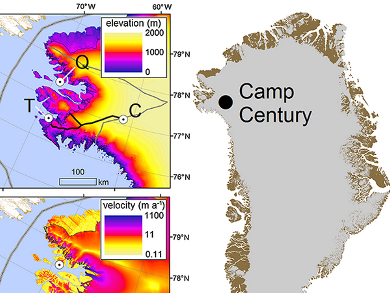The US military base “Camp Century” was built in 1959 around 200 km from the north-west coast of Greenland, deep in the eternal ice. The top-secret camp officially explored the Arctic as well as construction methods under permafrost conditions. This was also the version that moved the Danish Government to approve it. In reality, however, the possibility of nuclear missiles deployment in the Arctic was tested there. During the operation, 85–200 US soldiers lived in the “city under the ice”. A nuclear reactor provided the energy for life and work.
When the site was abandoned in 1967, the technicians dismantled the reactor. The entire rest of the infrastructure and all the waste was left behind. It was assumed that these environmentally harmful and partly toxic residues would be preserved for eternity under the meter-thick layer of ice. William Colgan, York University, Toronto, Ontario, Canada, and colleagues show that climate change destroys this hope.
Within the next 75 years, the ice sheet at Camp Century could melt under a business-as-usual anthropogenic emissions scenario. Net ablation would guarantee the eventual remobilization of physical, chemical, biological, and radiological wastes abandoned at the site.
Hidden under the ice, wastes and residues are spread over 55 hectares, the equivalent of roughly 100 football pitches. Among the toxic legacies are approximately 200,000 L of diesel fuel, 240,000 L of sewage, and an unknown amount of low level radioactive cooling water from the nuclear reactor. In addition, large parts of the area are contaminated with polychlorinated biphenyls (PCBs).
While Camp Century and four other contemporaneous ice sheet bases were legally established under a Danish-US treaty, the potential remobilization of their abandoned wastes, previously regarded as sequestered, represents an entirely new pathway of political dispute resulting from climate change. The controlled recovery of the waste is expensive and technically complex, yet is not even clear who would be responsible. However, there is time to negotiate the political responsibilities. According to the researchers, a recovery only makes sense when the ice above the station is almost completely melted.
- The abandoned ice sheet base at Camp Century, Greenland, in a warming climate,
W. Colgan, H. Machguth, M. MacFerrin, J. D. Colgan, D. van As, J. A. MacGregor,
Geophys. Res. Lett. 2016.
DOI:10.1002/2016GL069688


![Synthesis of [c2]Daisy Chains via Mechanochemistry](https://www.chemistryviews.org/wp-content/uploads/2025/04/202504_RotaxanesWithSolidStateMechanochemistry-125x94.png)

